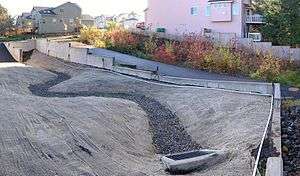Bioswale

Bioswales are landscape elements designed to remove silt and pollution from surface runoff water. They consist of a swaled drainage course with gently sloped sides (less than 6%) and filled with vegetation, compost and/or riprap.[1]:19 The water's flow path, along with the wide and shallow ditch, is designed to maximize the time water spends in the swale, which aids the trapping of pollutants and silt. Depending upon the geometry of land available, a bioswale may have a meandering or almost straight channel alignment. Biological factors also contribute to the breakdown of certain pollutants.[2]
A common application is around parking lots, where substantial automotive pollution is collected by the paving and then flushed by rain. The bioswale, or other type of biofilter, wraps around the parking lot and treats the runoff before releasing it to the watershed or storm sewer.
Contaminants addressed
There are several classes of water pollutants that may be arrested with bioswales. These fall into the categories of silt, inorganic contaminants, organic chemicals and pathogens. In the case of silt, these effects are resultant turbidity to receiving waters. Inorganic compounds may be metallic compounds such as lead, chromium, cadmium and other heavy metals. Lead is the most prevalent chemical of this class, deriving from automotive residue (for example, spillage of leaded gasoline). Other common inorganic compounds are macronutrients such as phosphates and nitrates. Principal sources of these nutrients are excess fertilization, which can cause eutrophication in receiving waters. Chief organic chemicals are pesticides, frequently over-dosed in agricultural and urban landscaping . These chemicals can lead to a variety of organism poisoning and aquatic ecosystem disturbance. Pathogens typically derive from surface runoff containing animal wastes and can lead to a variety of diseases in humans and aquatic organisms.
Examples
Two early examples of scientifically designed bioswales for large scale applications are found in the western US. In 1996 for Willamette River Park in Portland, Oregon a total of 2330 lineal feet of bioswale was designed and installed to capture and prevent pollutant runoff from entering the Willamette River. Intermittent check dams were installed to further abet silt capture, which reduced by 50% suspended solids entering the river system.[3]
A second example of a large scale designed bioswale is at the Carneros Business Park, Sonoma County, California. Starting in 1997 the project design team worked with the California Department of Fish and Game and County of Sonoma to produce a detailed design to channel surface runoff at the perimeter of a large parking area. Surface runoff consists of building roof runoff, parking lot runoff and overland flow from properties to the north of the project site. A total of two lineal miles of bioswale was designed into the project. The purpose of the bioswale was to minimize runoff contaminants from entering Sonoma Creek. The bioswale channel is grass-lined, and nearly linear in form. Downslope gradient is approximately 4% and cross-slope gradient is approximately 6%.[4]
See also
- Bioretention
- Infiltration
- Rain gardens
- Riparian zone
- Soil contamination
- Storm water
- Sustainable drainage system
- Urban runoff
- Water-sensitive urban design
References
- ↑ Loechl, Paul M.; et al. (2003). Design Schematics for a Sustainable Parking Lot (PDF). Champaign, IL: US Army Corps of Engineers, Research and Development Center. Construction Engineering Research Laboratory. Document no. ERDC/CERL TR-03-12.
- ↑ Hogan, C. Michael (2010). "Bioswale." Archived June 25, 2010, at the Wayback Machine. Encyclopedia of Earth. Eds. Marietta Loehrlein (Topic Editor); Cutler J. Cleveland. Washington, D.C.: Environmental Information Coalition, National Council for Science and the Environment.
- ↑ France, Robert L. (2002). Handbook of Water Sensitive Planning and Design. Boca Raton, FL: CRC Press. ISBN 1-56670-562-2.
- ↑ Lumina Technologies (1998). Hydrology and biology studies for Carneros Business Park, prepared for the William A. Saks Company pursuant to requirements of the County of Sonoma. Approximately 2000 bioswales are projected to be installed in New York City to protect the city's combined sewer system.
External links
- Combating Climate Change with Landscape Architecture Resource Guide
- Sustainable Residential Design: Improving Water Efficiency
- Xiao, Qingfu; McPherson, E. Gregory (2011). "Performance of engineered soil and trees in a parking lot bioswale". Urban Water Journal. 8 (4): 241–53. doi:10.1080/1573062X.2011.596213.